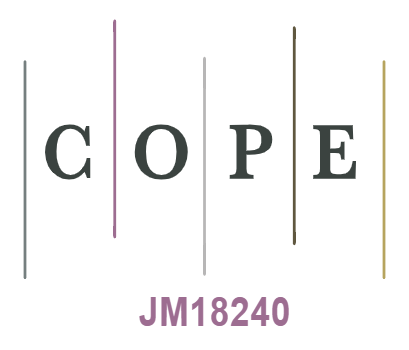اهمية العلامات التشريحية لتنبأ اتجاه سيادة الجيوب الوريدية المستعرضة بأستعمال الرنين المغناطيسي
DOI:
https://doi.org/10.32007/jfacmedbagdad.6511910الكلمات المفتاحية:
Hypoplastic transverse sinus; ، occipital lobe bending; ، occipital petalia; ، posterior falx angulation; ، transverse sinus dominanceالملخص
الخلفية : تعرض تصوير الجيوب الدماغية الوريدية عند استعمال الرنين المغناطيسي للتحديات التشخيصية لتفرقة الضمور الخلقي عن الخثر الدموية .
الغرض: تقييم قدرة العلامات التشريحية على توقع اتجاه سيادة الجيوب الوريدية المستعرضة اثناء فحص الرنين المغناطيسي للدماغ.
الطريقة والنتائج : اجري الفحص على مائة مريض اثناء فحص الرنين المغناطيسي للدماغ المتضمن تصوير الجيوب الوريدية وملاحظة اتجاه تدفق الجيب السهمي العلوي و اتجاه انحناء اخدود الجيب السهمي العلوي واتجاه انحراف المنجل السحائي الخلفي واتجاه انحناء الفص الخلفي للدماغ. حيث شكل اتجاه تدفق الجيب السمهي العلوي و اتجاه انحناء اخدود الجيب السهمي العلوي نحو اليمين اعلى نسبة توقع صحيحة لسيادة الجيب الوريدي المستعرض.
الاستنتاج : اظهرت العلامات التشريحية قدرة جيدة على توقع اتجاه سياده الجيوب الوريدية المستعرضة
التنزيلات
المراجع
1. Sparaco M, Feleppa M, Bigal ME. Cerebral venous thrombosis and headache-a case-series. Headache. 2015; 55: 806-14. https://doi.org/10.1111/head.12599
Damak M, Crassard I, Wolff V. Isolated lateral sinus thrombosis: a series of 62 patients. Stroke. 2009;40:476-81.
https://doi.org/10.1161/STROKEAHA.107.509711
Leach JL, Fortuna RB, Jones BV. Imaging of cerebral venous thrombosis: current techniques, spectrum of findings, and diagnostic pitfalls. Radiographics. 2006;26(Suppl 1):S19-41.
https://doi.org/10.1148/rg.26si055174
Mizeel AK, Taher NM. Outcomes of cerebral venous thrombosis in Al-Yarmook Teaching Hospital. Med J Babylon 2021;18:208-12. https://doi.org/10.4103/MJBL.MJBL_12_21
Abdullah, M. and Taher, N., 2020. diagnostic value of d-dimer serum level in patients with cerebral venous thrombosis. the Iraqi postgraduate medical journal, 19(3), pp.272-278.
Ayanzen RH, Bird CR, Keller PJ. Cerebral MR venography: normal anatomy and potential diagnostic pitfalls. AJNR Am J Neuroradiol. 2000;21:74-8.
Alper F, Kantarci M, Dane S, Gumustekin K, Onbas O, Durur I. Importance of Anatomical Asymmetries of Transverse Sinuses: An MR Venographic Study. Cerebrovascular Diseases. 2004;18(3):236-239.
https://doi.org/10.1159/000079960
Cure' JK, Van Tassel P, Smith MT. Normal and variant anatomy of the dural venous sinuses. Semin Ultrasound CT MR. 1994;15:499-519. https://doi.org/10.1016/S0887-2171(05)80019-8
Kitamura MAP, Costa LF, Silva DOA, Batista LL, Holanda MMA, Valença MM. Cranial venous sinus dominance: what to expect? Analysis of 100 cerebral angiographies. Arq Neuropsiquiatr. 2017 May;75(5):295-300. 282X20170042. PMID: 28591389. https://doi.org/10.1590/0004-282x20170042
Arsava EY, Arsava EM, Oguz KK, Topcuoglu MA. Occipital Petalia as a predictive imaging sign for transverse sinus dominance. Neurological Research. 2019;41(4):306-11. https://doi.org/10.1080/01616412.2018.1560643
Chik Y, Gottesman RF, Zeiler SR. Differentiation of transverse sinus thrombosis from congenitally atretic cerebral transverse sinus with CT. Stroke. 2012;43:1968-1970.. https://doi.org/10.1161/STROKEAHA.112.656124
Kertesz A, Black SE, Polk M, Howell J. Cerebral asymmetries on Magnetic Resonance Imaging. Cortex. 1986;22(1):117-27. https://doi.org/10.1016/S0010-9452(86)80036-3
Maller JJ, Thomson RHS, Rosenfeld JV, Anderson R, Daskalakis ZJ, Fitzgerald PB. Occipital bending in depression. Brain. 2014;137(6):1830-7. https://doi.org/10.1093/brain/awu072
Pettersson DR, McLouth JD, Addicott B. The gibraltar sign: an anatomic landmark for predicting transverse sinus dominance Laterality on Conventional MRI. J Neuroimaging. 2018 Jan; 28(1):99-105.
https://doi.org/10.1111/jon.12457
Leach JL, Strub WM, Gaskill-Shipley MF. Cerebral venous thrombus signal intensity and susceptibility effects on gradient recalled-echo MR imaging. Am J Neuroradiol 2007;28:940-5.
Stam J. Thrombosis of the cerebral veins and sinuses. N Engl J Med 2005;352:1791-8.
https://doi.org/10.1056/NEJMra042354
Kumar A, Mukund A, Sharma GL. Dural venous thrombosis-a neglected finding on routine MRI sequences. Indian J Radiol Imaging. 2006;16:276. https://doi.org/10.4103/0971-3026.29110
Patel CR, Fernandez-Miranda JC, Wang WH, Wang EW. Skull Base Anatomy. Otolaryngol Clin North Am. 2016 Feb;49(1):9-20. https://doi.org/10.1016/j.otc.2015.09.001
Cantu C, Barinagarrementeria F. Cerebral venous thrombosis associated with pregnancy and puerperium; review of 67 cases. Stroke. 1993;24:1880-1884. https://doi.org/10.1161/01.STR.24.12.1880
Hinman J, Provenzale J. Hypointense thrombus on T2- weighted MR imaging: A potential pitfall in the diagnosis of dural sinus thrombosis. Eur J Radiol. 2002;41:147-52. https://doi.org/10.1016/S0720-048X(01)00365-5
Pai V, Khan I, Sitoh Y, Purohit B. Pearls and Pitfalls in the Magnetic Resonance Diagnosis of Dural Sinus Thrombosis: A Comprehensive Guide for the Trainee Radiologist. Journal of Clinical Imaging Science. 2020;10:77.
https://doi.org/10.25259/JCIS_187_2020
Surendrababu NR, Subathira, Livingstone RS. Variations in the cerebral venous anatomy and pitfalls in the diagnosis of cerebral venous sinus thrombosis: low field MR experience. Indian J Med Sci. 2006;60:135- 142.
https://doi.org/10.4103/0019-5359.24677
Patel D, Machnowska M, Symons S, Yeung R, Fox AJ, Aviv RI, et al. Diagnostic performance of routine brain MRI sequences for dural venous sinus thrombosis. Am J Neuroradiol. 2016;37:2026-32. doi: 10.3174/ajnr.A4843.
https://doi.org/10.3174/ajnr.A4843
Jalli R, Zarei F, Farahangiz S, Khaleghi F, Petramfar P, BorhaniHaghighi A, et al. The sensitivity, specificity, and accuracy of contrast-enhanced T1-weighted image, T2*-weighted image, and magnetic resonance venography in diagnosis of cerebral venous sinus thrombosis. J Stroke Cerebrovasc Dis. 2016;25:2083-6. doi: 10.1016/j.jstrokecerebrovasdis.2016.01.0
https://doi.org/10.1016/j.jstrokecerebrovasdis.2016.01.039
Ayanzen RH, Bird CR, Keller PJ, McCully FJ, Theobald MR, Heiserman JE. Cerebral MR venography: normal anatomy and potential diagnostic pitfalls. AJNR Am J Neuroradiol. 2000 Jan;21(1):74-8. PMID: 10669228.
Saiki K, Tsurumoto T, Okamoto K. Relation between bilateral differences in internal jugular vein caliber and flow patterns of dural venous sinuses. Anat Sci Int. 2013 Jun;88(3):141-150. PubMed PMID: 23572397; PubMed Central PMCID: PMCPMC3654179. https://doi.org/10.1007/s12565-013-0176-z
التنزيلات
منشور
إصدار
القسم
الرخصة
الحقوق الفكرية (c) 2023 maryam AL-Ani

هذا العمل مرخص بموجب Creative Commons Attribution 4.0 International License.










 Creative Commons Attribution 4.0 International license..
Creative Commons Attribution 4.0 International license..


